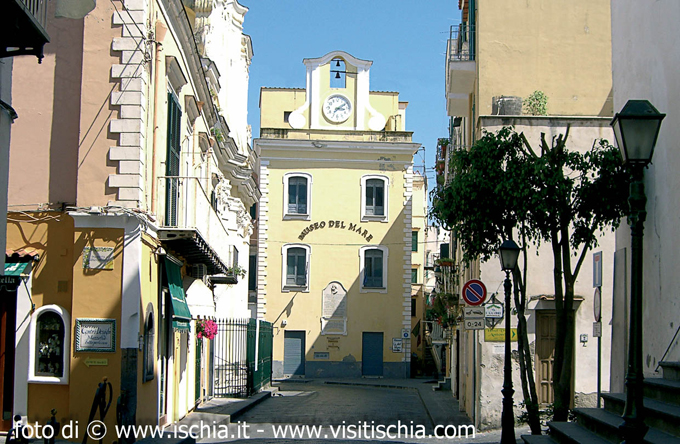Dermatology
10. The Clock Tower

Period: the 16th century.
Original use: public building.
Today’s use: museum.
Roofing: flat, terrazzo-style.
Vaults or attic: pavilion vault, flat attic.
Stairs: three flights of stairs.
Masonry: Masonry in tuff and lava stones with painted plaster.
Floors: brickwork.
External decorations: clock, marble memorial tablet.
The Clock Tower is found in Via L. Mazzella, 77
Since its foundation, the Clock Tower has always fulfilled its role as being the site serving as the Town Hall. In 1898, in a location plan to reorganize the entire village, it was mentioned as the “Municipio” (Town Hall). At the beginning of the 20th century, towards the twenties, the municipal site transferred over to the Mazzella building (Palazzo Mazzella).
The rooms of the Tower were used as elementary school rooms up until 1967. On December 15, 1996 the tower was inaugurated the Museo del Mare (the Sea Museum). The building’s shape as seen today dates back to 1759. During these years the ‘Decurioni’ (Members of Parliament of the ‘universities’ [today’s municipalities]), restructured the Tower with structures such as the Board room, various offices, and the use of the first floor as a jail. Until 1730, the general assemblies took place in the village’s tower (Torre del Borgo). In 1759, the tower was endowed with a municipal clock. At one time the clock’s face was marble; in 1960 it was substituted with a bright clock-face. Still in 1759, a basin in tiburtine rock was placed near the tower by the administration. Besides the 19th century memorial tablet commemorating the death of King Victor Emanuel II, today we can still read on the building’s frontispiece the more ancient and smaller tablet suggested by the Baron Antonini for the fountain: “Aquam ex fonte buceti a.d. ivmp publico aere derivatam la broque ex tiburtino lapide ornatam et turri in qua concilia fierent adpositam addito orario decuriones pthaecusani utendam fruendam civibus dedurunt ad 1759”[*].
[*] "The authorities gave the water to the citizens so that they could use it with joy. With the help of everyone’s money, it was obtained from the fountain of Buceto and now squirts in the beautiful basin of tiburtine stone.









